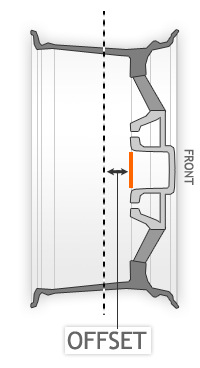 |
In common with many performance cars, the 964 came from the factory with rear wheels wider than the front. Largely because of the position of the engine and transmission, the extra tyre width helping support that biased weight distribution. Wheels widths are always described in inches, i.e. 7J, 8J etc. The "J" refers to the profile of the rim itself. Tyre widths are always described in millimeters, 225 for example. One additional parameter relating to the tyre is the tyre sidewall height, indicated by an aspect ratio figure following the width, i.e. 225/45. This indicates that the sidewall is 45% of the tyre width, i.e. 101.45mm. |
|
The Carrera 4 came as standard with 16" diameter "Design 90" alloy wheels - 6J on the front and 8J on the rear. Standard tyre size was 205/55 and 225/50 respectively. The wheels are designed to match the placement of the wheel bearing in the hub and, as such have a mounting face with a positive offset (as shown to the right) of 52.3mm. When replacing wheels it is important to maintain the correct offset to preserve the loads placed on the wheel bearing. Offsets (also referred to as "ET" or ' EinpressTiefe' ) may be varied with the aid of shims or spacers in cases where the replacement wheel is a different width to the original. Note that spacers/shims can only REDUCE an offset of a wheel, never increase it. In 1992 the Carrera 2 and 4 got the "Design 92" wheels - also called "Cup" or "Cup 1" wheels in 16" and, optionally, 17" diameter. The 17" wheels were standard on the Turbo cars from launch in 1991 (in 7J/9J sizes) and from 1992 on the RS in magnesium alloy in 7.5J and 9J sizes. Another term related to the wheels is the bolt pattern. Most Porsche wheels use 5 bolts on an imaginary circle around the hub which has a diameter of 130mm - this is called the Pitch Circle Diameter, or PCD, often shown as 5x130. |
 |
|
Porsche and Carrera are trademarks and are the exclusive property of Dr. Ing. h.c.F. Porsche AG |
|